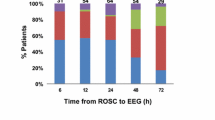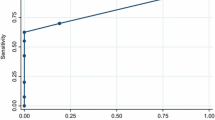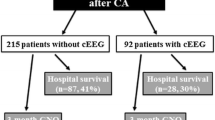Abstract
Background
Lack of electroencephalography (EEG) background reactivity during therapeutic hypothermia (TH) has been associated with poor outcome in post-anoxic comatose patients. However, decision on intensive care withdrawal is based on normothermic (NT) evaluations. This study aims at exploring whether patients showing recovery of EEG reactivity in NT after a non-reactive EEG in TH differ from those remaining non-reactive.
Methods
Patients with non-reactive EEG during TH were identified from our prospective registry of consecutive comatose adults admitted after successful resuscitation from CA between April 2009 and June 2014. Variables including neurological examination, serum neuron-specific enolase (NSE), procalcitonin, and EEG features were compared regarding impact on functional outcome at 3 months.
Results
Seventy-two of 197 patients (37 %) had a non-reactive EEG background during TH with thirteen (18 %) evolving towards reactivity in NT. Compared to those remaining non-reactive (n = 59), they showed significantly better recovery of brainstem reflexes (p < 0.001), better motor responses (p < 0.001), transitory consciousness improvement (p = 0.008), and a tendency toward lower NSE (p = 0.067). One patient recovering EEG reactivity survived with good functional outcome at 3 months.
Conclusions
Recovery of EEG reactivity from TH to NT seems to distinguish two patients’ subgroups regarding early neurological assessment and transitory consciousness improvement, corroborating the role of EEG in providing information about cerebral functions. Understanding these dynamic changes encourages maintenance of intensive support in selected patients even after a non-reactive EEG background in TH, as a small subgroup may indeed recover with good functional outcome.

Similar content being viewed by others
References
Friberg H, Cronberg T. Prognostication after cardiac arrest. Best Pract Res Clin Anaesthesiol. 2013;27(3):359–72.
Sandroni C, Cavallaro F, Callaway CW, et al. Predictors of poor neurological outcome in adult comatose survivors of cardiac arrest: a systematic review and meta-analysis. Part 2: Patients treated with therapeutic hypothermia. Resuscitation. 2013;84(10):1324–38.
Sandroni C, Cavallaro F, Callaway CW, et al. Predictors of poor neurological outcome in adult comatose survivors of cardiac arrest: a systematic review and meta-analysis. Part 1: Patients not treated with therapeutic hypothermia. Resuscitation. 2013;84(10):1310–23.
Wijdicks EFM, Hijdra a, Young GB, Bassetti CL, Wiebe S. Practice parameter: prediction of outcome in comatose survivors after cardiopulmonary resuscitation (an evidence-based review): report of the Quality Standards Subcommittee of the American Academy of Neurology. Neurology. 2006;67(2):203–10.
Fugate JE, Wijdicks EFM, Mandrekar J, et al. Predictors of neurologic outcome in hypothermia after cardiac arrest. Ann Neurol. 2010;68(6):907–14.
Engel H, Ben Hamouda N, Portmann K, et al. Serum procalcitonin as a marker of post-cardiac arrest syndrome and long-term neurological recovery, but not of early-onset infections, in comatose post-anoxic patients treated with therapeutic hypothermia. Resuscitation. 2013;84(6):776–81.
The Hypothermia after Cardiac Arrest Study Group. Mild therapeutic hypothermia to improve the neurologic outcome after cardiac arrest. N Engl J Med. 2002;346(8):549–56.
Bernard S, Gray T, Buist M, et al. Treatment of comatose survivors of out-of-hospital cardiac arrest with induced hypothermia. N Engl J Med. 2002;346(8):557–63.
Oddo M, Schaller M-D, Feihl F, Ribordy V, Liaudet L. From evidence to clinical practice: Effective implementation of therapeutic hypothermia to improve patient outcome after cardiac arrest. Crit Care Med. 2006;34(7):1865–73.
Nielsen N, Wetterslev J, Cronberg T, et al. Targeted temperature management at 33 °C versus 36 °C after cardiac arrest. N Engl J Med. 2013;369(23):2197–206.
Horn J, Cronberg T, Taccone FS. Prognostication after cardiac arrest. Curr Opin Crit Care. 2014;20(3):280–6.
Stub D, Bernard S, Duffy SJ, Kaye DM. Post cardiac arrest syndrome: a review of therapeutic strategies. Circulation. 2011;123(13):1428–35.
Greer DM, Rosenthal ES, Wu O. Neuroprognostication of hypoxic-ischaemic coma in the therapeutic hypothermia era. Nat Rev Neurol. 2014;10(4):190–203.
Cronberg T, Brizzi M, Liedholm L, et al. Neurological prognostication after cardiac arrest—recommendations from the Swedish Resuscitation Council. Resuscitation. 2013;84:867–72.
Oddo M, Rossetti AO. Early multimodal outcome prediction after cardiac arrest in patients treated with hypothermia. Crit Care Med. 2014;42(6):1340–7.
Alvarez V, Sierra-Marcos A, Oddo M, Rossetti AO. Yield of intermittent versus continuous EEG in comatose survivors of cardiac arrest treated with hypothermia. Crit Care. 2013;17(5):R190.
Thenayan EL, Savard M, Sharpe MD, Norton L, Young B. Electroencephalogram for prognosis after cardiac arrest. J Crit Care. 2010;25(2):300–4.
Tsetsou S, Oddo M, Rossetti AO. Clinical outcome after a reactive hypothermic EEG following cardiac arrest. Neurocrit Care. 2013;19(3):283–6.
Hirsch LJ, LaRoche SM, Gaspard N, et al. American Clinical Neurophysiology Society’s Standardized Critical Care EEG Terminology: 2012 version. J Clin Neurophysiol. 2013;30(1):1–27.
Rossetti AO, Oddo M, Logroscino G, Kaplan PW. Prognostication after cardiac arrest and hypothermia: a prospective study. Ann Neurol. 2010;67(3):301–7.
Booth CM, Boone RH, Tomlinson G, Detsky AS. Is this patient dead, vegetative, or severely neurologically impaired? Assessing outcome for comatose survivors of cardiac arrest. J Am Med Assoc. 2004;291(7):870–9.
Posner J, Sapper C, Schiff N, Plum F. Plum and Posner’s diagnosis of stupor and coma. 4th ed. New York: Oxford University Press; 2007.
Jennett B, Teasdale G. Aspects of coma after severe head injury. Lancet. 1977;1(8017):878–81.
Van Putten MJAM. The N20 in post-anoxic coma: are you listening? Clin Neurophysiol. 2012;123(7):1460–4.
Rossetti AO, Carrera E, Oddo M. Early EEG correlates of neuronal injury after brain anoxia. Neurology. 2012;78(11):796–802.
Cronberg T, Rundgren M, Westhall E, et al. Neuron-specific enolase correlates with other prognostic markers after cardiac arrest. Neurology. 2011;77(7):623–30.
Noirhomme Q, Lehembre R, LugoZdel R, et al. Automated analysis of background EEG and reactivity during therapeutic hypothermia in comatose patients after cardiac arrest. Clin EEG Neurosci. 2014;45:6–13.
Crepeau AZ, Fugate JE, Mandrekar J, et al. Value analysis of continuous EEG in patients during therapeutic hypothermia after cardiac arrest. Resuscitation. 2014;85(6):785–9.
Crepeau AZ, Rabinstein A, Fugate JE, et al. Continuous EEG in therapeutic hypothermia after cardiac arrest: prognostic and clinical value. Neurology. 2013;80(4):339–44.
Acknowledgments
The authors thank Christine Staehli (RN), the EEG fellows and technologists, and the ICU fellows and nurses for their help in data collection. The Swiss National Science Foundation provides financial support to AOR and EJ (CR3213_143780) and MO (320030_138191).
Disclosures
The authors declare that they have no other conflict of interest.
Author information
Authors and Affiliations
Corresponding author
Rights and permissions
About this article
Cite this article
Juan, E., Novy, J., Suys, T. et al. Clinical Evolution After a Non-reactive Hypothermic EEG Following Cardiac Arrest. Neurocrit Care 22, 403–408 (2015). https://doi.org/10.1007/s12028-014-0095-4
Published:
Issue Date:
DOI: https://doi.org/10.1007/s12028-014-0095-4




